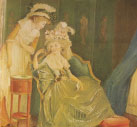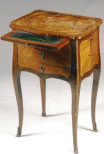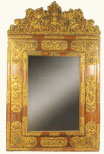
Thanks to our experience, we are able to propose your some practical advice in order to guide our clients and friends to a winning strategy to purchase.
FIRST ADVICE
We can observe every day that the market of art and antiques is unfortunately a game where no holds barred.
Thus, without speaking about the forgers who build old furniture with new ones, the risk to be misled can be found in the descriptions and in the voluntary or not ambiguity between the different notions.
| Antiques Only the more than hundred years old items are internationally admitted as antiques. The other items are secondhands market or even flea market. As time goes by, a natural selection eliminates the items that were not well built and preserved by the previous generations. Time naturally adds a value of rarity.. For example, items that were built at the beginning of the XXth century until the thirties can be considered like precious items but will only be antiques in 2030. |
|||||||||||||
|
|||||||||||||
| Style object applies to old and genuine objects but which period of making is more or less late and that must be precised. For example a chest of drawer of Louis XVI style is an antique but of style Louis XVI and period Napoleon III. The value of a period object is of course not the same than the one of a style object. |
|||||||||||||
| Descriptions The risk to be misled is also important in the explanatory leaflets. For example, there is a large difference between « signed by or stamped by » and « bears the signature or the stamp of ». There is also a big difference between « attributed to », « of the circle of » and « in the style of » More and more disputes are brought before the courts because of the ambiguity of the objects description between transactions. But even more numerous are the disputes amicably settled. Here are two examples. . |
|||||||||||||
The expert admitted that and our clients could define a reasonable price not to exceed, with a good knowledge of its qualities and defaults.
Comments : One of our clients has bought this object and when he brought it to our workshop to restore it, we have notices that :
On that basis, our client was able to point out that he had bought this object for his fundamental qualities as described in the catalogue and that these qualities did not exist.
So there was a fault on the substance. After a discussion with the expert, who confirmed our remarks, our client was reimbursed (except the transport costs). |
SECOND ADVICE
It is essential that you can be in a position to make yourself a serious and concrete opinion about the real quality of the object you would like to buy.
All the more so since the conservation state and the restoration possibilities are important criteria which determine specific value of an object in its category.
Here are some tricks to form an opinion on the quality of an object
1. five steps back
Examine the proportions of the furniture : Is there something wrong ? Disproportion of the legs, of the marble ?...2. Close to the furniture
-
a. its marble
 |
|
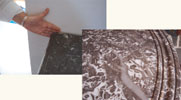 |
b. its bronze or brass (handles, locks, ferrule...)
 |
|
 |
c. Woodworks
 |
|
 |
3. Open the furniture
 |
|
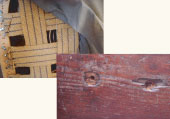 |
About the auctions
|
Never forget that the « general sale conditions » include a « Guarantee » chapter which typically holds that « no complaint will be accepted after the auction, since the buyers could examine the objects during the previous show.». So it is very wise to form oneself an opinion about the object before the auction. (nos services – conseil /représentation) |
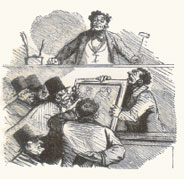 |
THIRD ADVICE : a golden rule
After a detailed examination, if you are still interested, never hesitate to request a precise and complete certificate from the seller and from the expert (Commitment).
If you could not proceed to a detailed examination,
if the seller does not accept to provide a certificate
if you have a doubt about the « value » of his signature,
You have to weigh up the importance of your interest for this object and the incurred potential financial risk.
but also considering the possibility that exists to find in the near future a similar object to another trustworthy professional who will give you all the appropriate guarantees.
© L'Atelier Anne-Marie FRERE s.a. 2009
